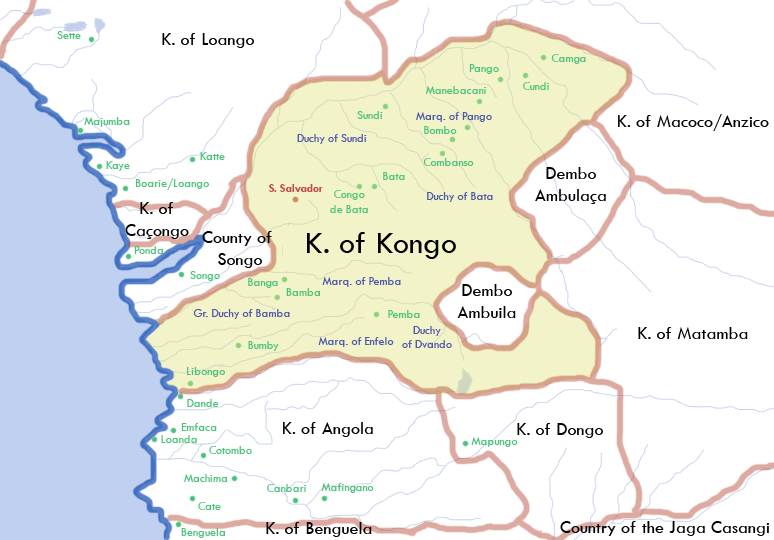Kingdom of Kongo (Q536965): Difference between revisions
Jump to navigation
Jump to search
(Created claim: Wikimedia Commons Item image (P189): Brooklyn Museum 22.1203 Grave Marker Tumba (2).jpg) |
(Created claim: Wikimedia Commons Item image (P189): The Bansa, or residence of the King of Kongo, called St. Salvador (M'Banza Kongo), Astley 1745.jpg) |
||
| Property / Wikimedia Commons Item image | |||
| Property / Wikimedia Commons Item image: The Bansa, or residence of the King of Kongo, called St. Salvador (M'Banza Kongo), Astley 1745.jpg / rank | |||
Normal rank | |||
| Property / Wikimedia Commons Item image: The Bansa, or residence of the King of Kongo, called St. Salvador (M'Banza Kongo), Astley 1745.jpg / qualifier | |||
Title: La capitale du Kongo, São Salvador | |||
Revision as of 13:11, 11 July 2023
kingdom in Central Africa located in present-day northern Angola, the western portion of the Democratic Republic of the Congo, and the Republic of the Congo
- Wene wa Kongo
- Kongo dya Ntotila
- Reino do Congo
| Language | Label | Description | Also known as |
|---|---|---|---|
| English | Kingdom of Kongo |
kingdom in Central Africa located in present-day northern Angola, the western portion of the Democratic Republic of the Congo, and the Republic of the Congo |
|
Statements
1395
0 references
6°16'0.001"S, 14°15'0.000"E
0 references
1914
0 references
KingdomKongo1711.png
774 × 540; 146 KB
774 × 540; 146 KB
Königreich Kongo in den Grenzen um 1711. Das Reich befand sich zu diesem Zeitpunkt auf dem heutigen Staatsgebiet von Angola, der DR Kongo und der Republik Kongo.
0 references
Kongo audience.jpg
640 × 491; 173 KB
640 × 491; 173 KB
Der Mani-Kongo João I. gewährt 1482 portugiesischen Seefahrern und Emissären um Diogo Cão eine Audienz. Radierung von Johann Theodor de Bry im Buch Índias Orientais, 1597. Das Königreich Kongo war, neben dem Königreich Lunda, das bedeutendste zentralafrikanische Staatswesen seiner Zeit.
0 references
Olfert Dapper, Naukeurige Beschrijvinge.jpg
1,200 × 908; 346 KB
1,200 × 908; 346 KB
König Garcia II. von Kongo empfängt niederländische Gesandte, die vor ihm knien. Radierung aus dem Buch Olfert Dapper: Naukeurige Beschrijvinge, 1668.
0 references
Lossy-page1-1171px-Kongo 1648 coloured.png
1,171 × 1,024; 189 KB
1,171 × 1,024; 189 KB
The Kingdom of Kongo in 1648
0 references
Brooklyn Museum 22.1203 Grave Marker Tumba (2).jpg
1,205 × 1,536; 168 KB
1,205 × 1,536; 168 KB
Kongo (Boma subgroup). 19th century Grave Marker (Tumba). The Kongo people placed stone figures called tumba on the graves of powerful people. His cap (mpu) with four leopard's teeth, the beaded necklace, and the bracelet (nlunga) identify him as a chief. The term tumba comes from the old Portuguese word for "tomb"—this genre may have been inspired by grave monuments for European merchants and missionaries in Kongo cemeteries. Brooklyn Museum
0 references
La capitale du Kongo, São Salvador
0 references
Identifiers
Sitelinks
Wikipedia(4 entries)
- dewiki Königreich Kongo
- enwiki Kingdom of Kongo
- frwiki Royaume du Kongo
- ruwiki Королевство Конго
Wikinews(0 entries)
Wikiquote(0 entries)
Wikisource(0 entries)
Wikivoyage(0 entries)
Other sites(1 entry)
- wikidatawiki Q796583






